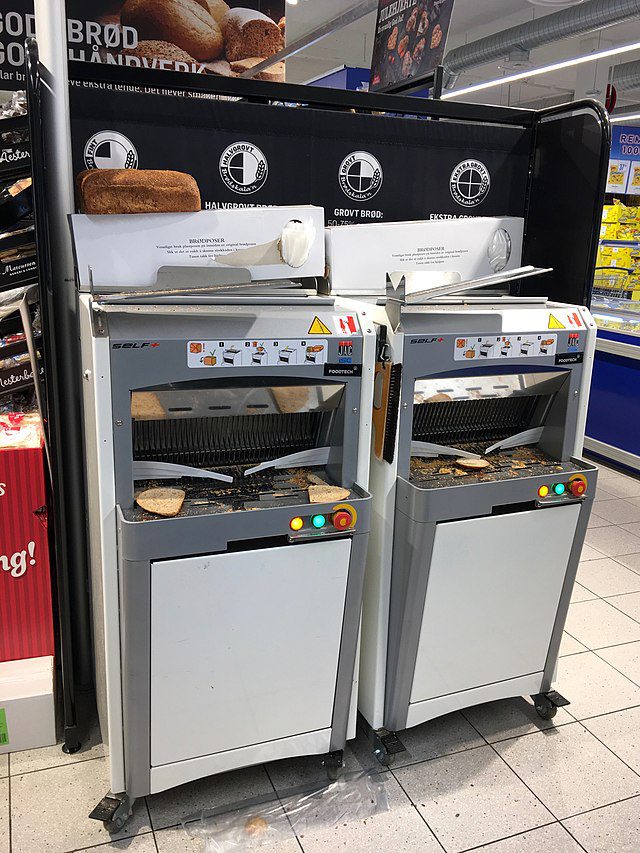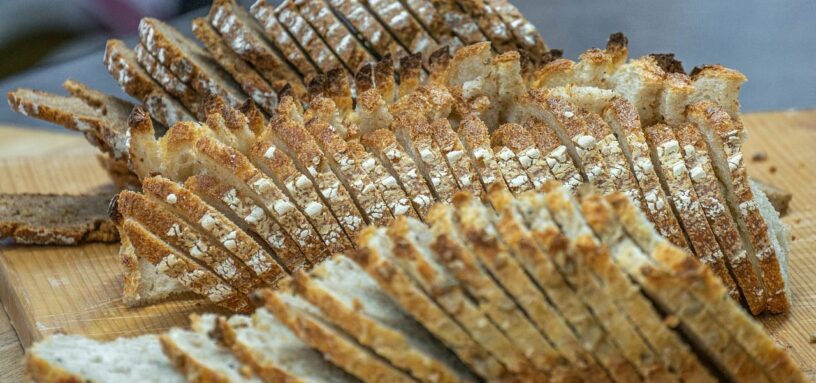10 Things You Didn’t Know About the Inventor of The Bread Slicer
The Amazing Bread Slicer, a simple yet revolutionary device, has radically changed how we consume a standard loaf of bread in the expanding world of culinary pleasures. Breakfasts, picnics, and luncheon spreads worldwide have been subtly changed by this straightforward tool’s capacity to slice an average loaf into absolutely equal pieces.
We uncover the invisible narrative of how this inconspicuous device has travelled through time, leaving behind a path of practicality, efficacy, and delicious moments that have become an essential component of our daily lives as we dig into the history and physics of this extraordinary invention.
Otto Frederick Rohwedder invented the first bread-slicing machine for a single loaf in Davenport, Iowa, in the United States. His prototype was damaged in a fire in 1912, and Rohwedder didn’t have a fully operating machine until 1928.
On July 7, 1928, the Chillicothe Baking Company of Chillicothe, Missouri, utilized the gadget for the first time in a commercial environment when they sold their first slices. Their “Kleen Maid Sliced Bread” was a big hit. The ten things you didn’t know about Otto Frederick Rohwedder are in the article.
1. Rohwedder was the son of jeweller
On July 7, 1880, Otto Frederick Rohwedder was born to Frank Rohwedder and Amanda Rohwedder. Frank Rohwedder, is a talented and inventive jeweller. Frank Rohwedder, Otto Rohwedder’s brother, and Emma Rohwedder, their sister, made up their family.
His hometown was Davenport, Iowa, where he was born and reared. Otto Rohwedder was raised in this delightful city where he was born, and it was here that his invention blossomed, leading him to build the revolutionary bread-slicing machine that changed the course of culinary history.
2. Frederick Rohwedder was initially a jeweller

020211127 Untersiebenbrunn style jewellery in Poland.jpg Silar, CC BY-SA 4.0, via Wikimedia Commons
Otto Frederick Rohwedder collaborated with famous jewellers to make his idea a reality around the turn of the twentieth century. Diamond & Co. was one of the notable companies he worked with, and their rigorous attention to detail and high-calibre workmanship perfectly complimented the intricate mechanics required for the bread slicer.
To improve the product’s aesthetic and usefulness, Rohwedder worked with Sapphire Innovations Ltd., a business known for its attention to design and innovation.
3. He sold his jewellery stores to make a bread-slicing machine

Bread slicing machine Foodtech brødskjæremaskin REMA 1000 Norway 2017-11-03.jpg Wolfmann, CC BY-SA 4.0, via Wikimedia Commons
Working in the jewellery industry assisted Rohwedder in realizing his ambition of being the certified inventor of the bread-slicing machine. As a result, after acquiring three jewellery firms, Rohwedder was certain that his ambition of creating the bread slicer was a reality.
He sold his jewellery enterprises to fund machine research and manufacture (Bread Slicing-Machine). Through these extraordinary collaborations, Rohwedder’s bread-slicing machine became a true culinary gem.
4. His invention was hit by fire which brought a huge setback
A calamity occurred in 1917 when the plant where Rohwedder was producing his equipment caught fire. His prototype and blueprints were both destroyed, putting an end to his grandiose ambition.
Rohwedder had an uphill battle to secure new funding, delaying the delivery of his product for several years. It was difficult for many innovators of his financial calibre at the time to continue with the task. It was painful and disheartening.
5. Rohwedder successfully designed his machine in 1927
If you examine the concept attentively, you will notice that it matured 10 years following the fire’s annual eruption. This was the setback that halted his initial bread-slicing machine concepts. Rohwedder was motivated by his persistence and devotion.
The machine was a marvel to see since it had no known flaws, but it also had an extra function in addition to the original invention. The machine not only cut but also wrapped the bread. He acquired patents to protect his concept.
In 1928, he sold his first machine to a friend and baker named Frank Bench, who installed it at the Chillicothe Baking Company in Chillicothe, Missouri. The first loaf of sliced bread was marketed commercially on July 7, 1928. The machine’s sales to other bakeries grew, and sliced bread became widely available across the country.
6. Rohwedder sold his patent rights to the Micro-Westco Co. of Bettendorf in 1930

A sliced loaf of bread. jpg by ChiemSeherin, via Pixabay
1933 was unquestionably a year of considerable upheaval and ambition for Rohwedder. The year specifically indicates how the populace acquired bread. For the first time, American bakeries produced more sliced bread loaves than unsliced bread loaves in 1933.
The same year he sold his invention rights to Micro-Westco Co. in Bettendorf, Iowa, Rohwedder joined the company. He climbed to the ranks of vice president and sales manager at the Rohwedder Bakery Machine Division.
7. Rohwedder had seven patents approved from 1927 to 1936

St. Louis electrical bread slicer, 1930.png See page for author, Public domain, via Wikimedia Commons
Otto Frederick Rohwedder accomplished an incredible achievement by gaining seven ground-breaking patents in the field of bread handling and slicing. This was between 1927 and 1936. In 1927, the critical work that allowed for further breakthroughs was done. The following patents addressed a wide range of improvements.
He improved the effectiveness of the bread-slicing process in 1928. His breakthrough conveyor systems had transformed bread handling by 1930. This therefore simplified manufacturing and improved accuracy.
In 1931, Rohwedder’s innovation prioritized operator safety when executing slicing procedures, marking a watershed moment. As he persevered in his pursuit of development, the bread-slicing machine’s overall efficacy and reliability improved in 1933.
In 1935, he remained dedicated to advancement. In 1936, his finest achievement solidified Rohwedder’s fame by making the bread-slicing machine. This was an important piece of equipment in modern households and bakeries all over the world.
8. Unlike other notable inventors, Rohwedder was a family man

Grave of Otto Frederick Rohwedder (1880–1960) at Riverside Cemetery, Albion, Michigan.jpg Nick Number, CC BY-SA 4.0, via Wikimedia Commons
Rohwedder married Carrie Johnson in 1905. Margaret and Richard, their two children, were raised in St. Francisville, Louisiana. Rohwedder and his wife Carrie moved to Albion, Michigan, where their daughter Margaret (Rohwedder) Steinhauer and his sister Elizabeth Pickerill lived, after leaving Micro-Westco Co. in 1951 at the age of 71. Rohwedder died on November 8, 1960, in Concord, Michigan. He was put to rest in Albion’s Riverside Cemetery.
9. Rohwedder’s original bread-slicing machine is in the Smithsonian Institution

Smithsonian Institution Building, Washington DC – panoramio.jpg MARELBU, CC BY 3.0, via Wikimedia Commons
The Smithsonian Institution was founded by the American government “for the increase and diffusion of knowledge” and is the world’s largest complex of museums, educational institutions, and research centres. It was founded on August 10, 1846. It is a trust instrumentality that is not legally affiliated with any of the three branches of the federal government.
The institute is named after the British scientist and philanthropist James Smithson. It was founded as the United States National Museum, but the name was dropped in administrative terms in 1967.
The bread-slicer changed the way we ate bread and had a long-lasting influence on how we live our lives, as shown by the fact that it is now housed in the Smithsonian. Visitors recognize Rohwedder’s brilliance while marvelling at this technological feat. We enjoy the comfort and delight that sliced bread has provided to both the past and the present.
10. Rohwedder was license optometrist

Navy optometrist gives eye exams .jpg Maj. Satomi Mack-Martin, Public domain, via Wikimedia Commons
Optometrists are medical experts who provide comprehensive primary eye care. Optometrists are Doctor of Optometry holders in the United States and Canada. They are qualified and permitted to perform medicine for eye issues in addition to providing therapy for refractive (optical) eyes.
Rohwedder got a degree in optics from what is now the Illinois College of Optometry in Chicago, in addition to studying optometry.
Otto Frederick Rohwedder’s innovative invention has permanently transformed the way we enjoy bread. His legacy lives on as a representative of innovation because of his dedication and ability to overcome hurdles to get seven key patents. Because of Rohwedder’s unshakable character, we will always be grateful for the gift of sliced bread, which he gave to us.
Read On 30 Famous Black Chefs Who Are Changing the Food Industry
Planning a trip to Paris ? Get ready !
These are Amazon’s best-selling travel products that you may need for coming to Paris.
Bookstore
- The best travel book : Rick Steves – Paris 2023 – Learn more here
- Fodor’s Paris 2024 – Learn more here
Travel Gear
- Venture Pal Lightweight Backpack – Learn more here
- Samsonite Winfield 2 28″ Luggage – Learn more here
- Swig Savvy’s Stainless Steel Insulated Water Bottle – Learn more here
Check Amazon’s best-seller list for the most popular travel accessories. We sometimes read this list just to find out what new travel products people are buying.










